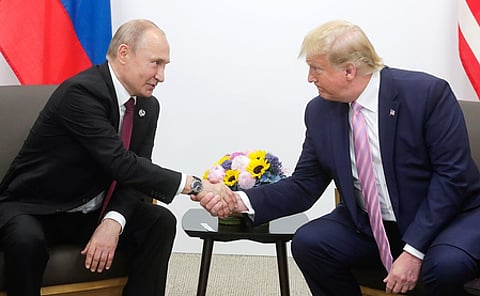Ukraine war: Why Trump picked Alaska for his meeting with Putin
Alaska is geographically and historically tied to Russia, making it a fitting backdrop

US President Donald Trump will host Russian President Vladimir Putin for talks on the Ukraine war at Joint Base Elmendorf-Richardson in Alaska on Friday. The choice of location is no coincidence: Alaska is geographically and historically tied to Russia, making it a fitting backdrop for high-stakes diplomacy.
Alaska’s strategic location at the edge of the American continent, just across the Bering Strait from Russia, serves as a literal and metaphorical bridge between the two nations. In fact, the Diomede Islands — one Russian, one American — are only three kilometres apart.
This unique geography is rooted in deep history. Around 10,000 years ago, during the last Ice Age, a land bridge connected Alaska to Russia’s Far East. It’s believed this is how the first humans migrated to North America. The region’s indigenous peoples, including the Aleuts, still reflect that ancient link. The name “Alaska” itself comes from the Aleut word Alyaska, meaning “mainland.”
Russian interest in Alaska dates back to the early 18th century. In 1725, Tsar Peter the Great sent Danish explorer Vitus Bering to chart the Alaskan coast. Over the next decades, Russian explorers and fur traders arrived, exploiting the region’s rich natural resources — particularly sea otter pelts.
In 1799, Tsar Paul I formalised Russian governance by granting a monopoly to the Russian-American Company, which established settlements like Sitka, the colonial capital. However, this era of expansion came at a cost. The native Tlingit people were forcefully subdued in 1804, and overhunting eventually depleted Alaska’s wildlife.
Why Russia sold Alaska
By the mid-19th century, the fur trade had declined, and Russia faced mounting economic problems, especially following its defeat in the Crimean War (1853–1856). Russia spent the equivalent of 160 million pounds sterling during the war, according to Advocate for Peace, a 19th-century US journal.
Alaska, now yielding little profit and sitting uncomfortably close to British-controlled Canada, became a liability. Russia feared losing the territory in a future conflict with Britain. So, Tsar Alexander II opted to sell it — and the United States, in the midst of westward expansion, was eager to buy.
In 1867, the Alaska Purchase was finalised for $7.2 million — a massive sum at the time, often ridiculed as “Seward’s Folly.” But history proved it a bargain.
For decades, Alaska was dismissed as a frozen wilderness. That changed in 1967 with the discovery of vast oil reserves, which triggered an economic boom that continues today.
Not the first diplomatic meeting in Anchorage
Alaska has played host to international diplomacy before. In September 1971, Japanese Emperor Hirohito landed in Anchorage during his first overseas trip. After meeting President Richard Nixon, he continued on to Europe. That meeting underscored Alaska’s role as a global gateway — a role it continues to play today.
As the Ukraine war dominates international headlines, the decision to hold talks in Alaska blends deep history with modern geopolitics — offering a stark reminder that the past still shapes today’s power plays.
Sign up for the Daily Briefing
Get the latest news and updates straight to your inbox







